Blueschord. They are just chords and are drawn from all four chord categories (open position, movable form, a.k.a.
barrechords, and 4-part
Jazzchords). From basic open position chords and basic movable for chords to triads, 4-part a.k.a. “Jazz” chords and simply knowing the notes of the ukulele fingerboard and the names of the individual chord tones of a chord.
Blues Chordsare just any chord you are playing a
Blueswith. Typically the Seventh, a.k.a. Dominant Seventh chord.
barre chords, and Triads , 4-part a.k.a. “Jazz” Chords and Free Form Chords where it's just simply knowing the notes of the ukulele fingerboard and the Names of the Individual Chord Tones of a chord.
jazzsetting the chords can adapt the extended harmonies common to a jazz blues such as ninths, thirteenths and altered chords.
CoreSeventh Chords
You need ONE chord, four voicings, that can serve a foundation for building ALL your 4-part, contemporary “jazz” chords. These 4-part chords, sometimes called “Jazz” chords are simply 4-part chords. The seventh chords, sometimes called The Dominant Seventh Chord is a great starting chord for that purpose.
Most professional guitarists' have a core set of chords that form the foundation for all their 4-part chords. Ukulele players need this same foundation.
A Seventh chord is a great starting chord to form your “core” chord foundation. The seventh chord forms the foundation for all our major 4-part chord types. From your core seventh chords, you can create the minor, diminished and augmented chord types.
Six 4-part chords that form the foundation for all your jazz chords: the seventh, major seventh, minor seventh, half-diminished seventh, diminished seventh and augmented seventh chords as your core foundations chords. Virtuoso jazz guitarist Chuck Anderson calls these the “Big Six”, a great name.
Most ukulele players already know the four open position versions that form the core seventh chords. You might already recognize a few of them below.




These Four Open Position Chords form the foundation for ALL your Jazz
chords.
Studying the blues chord progressions presented in this book will open a wealth of creative possibilities for exploring chord progressions in all styles of music, not just blues.
A Guide to Blues Chord Progressions for Ukulele A to Z starts with a basic three chord, 12 bar blues and progresses through 26 blues progression in C and G tuning up to a sophisticated jazz blues with multiple chord substitutions.
All examples are shown in C and G tuning. Suitable for Soprano, Concert, Tenor, and Baritone ukuleles. Get through this book and you'll have a solid jazz chord foundation to build on.
Available as a FREE PDF download FREE for Premium Members. Hard-copy available.

"Core Chords" are a concept that I typically apply to 4-part chords and your more contemporary modern chords. This where a solid foundation of a core set of chords really help in learning the massive amount of chords that are required for play contemporary music or jazz on ukulele or guitar. Not such a task on ukulele with on one four string set of strings to build your 4-part chords vs. the theoretically possible 15 sets available for guitar.
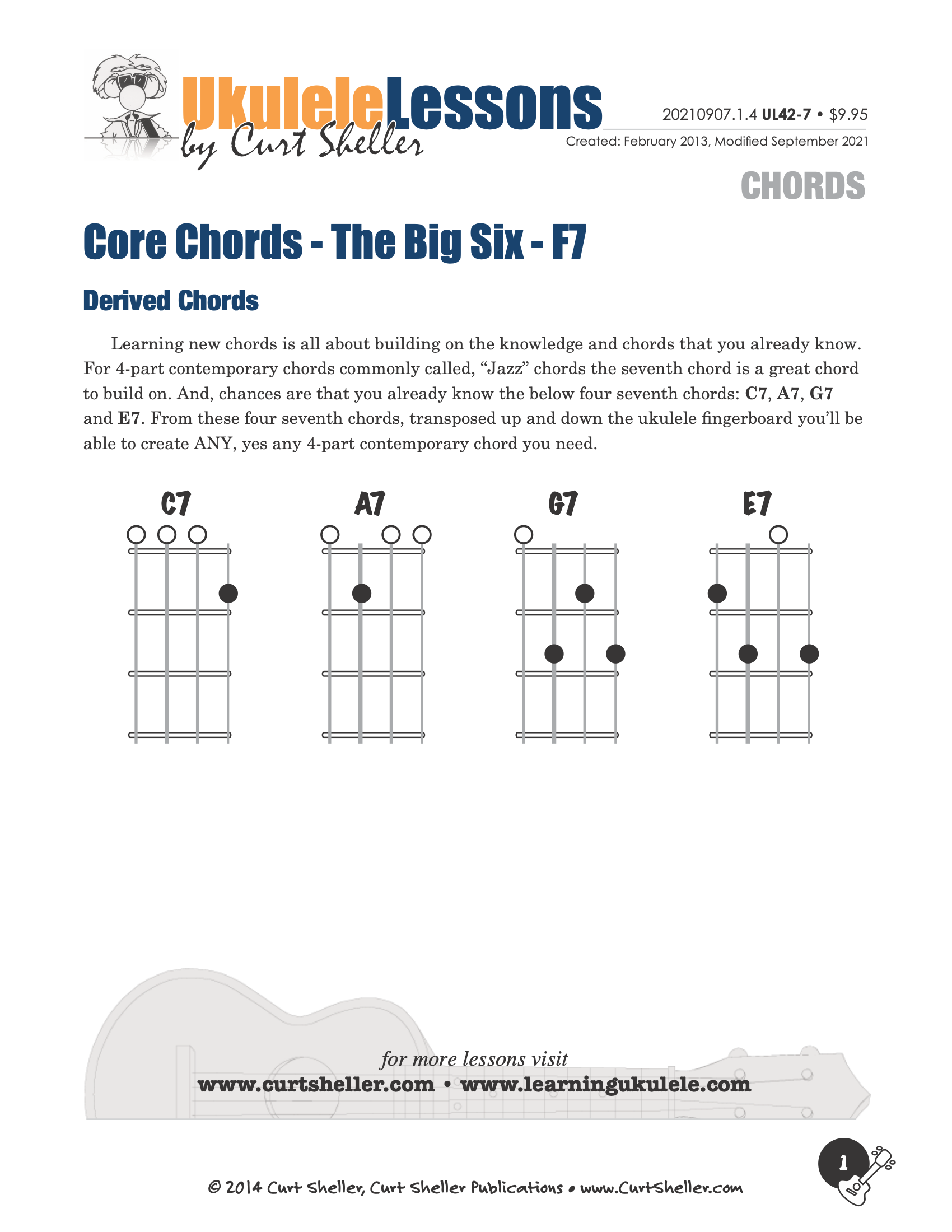
The Big Six Core Chords is a series of lessons for building your core, essential 4-part chords. These chords commonly called jazz chords, are really just 4-part chords used in a wide range of musical styles. These chords include: Seventh , Major Seventh, Minor Seventh, Half Diminished Seventh or Minor Seven Flat Five, Diminished Seventh, and Augmented Seventh. These six chords form a core set of chords.
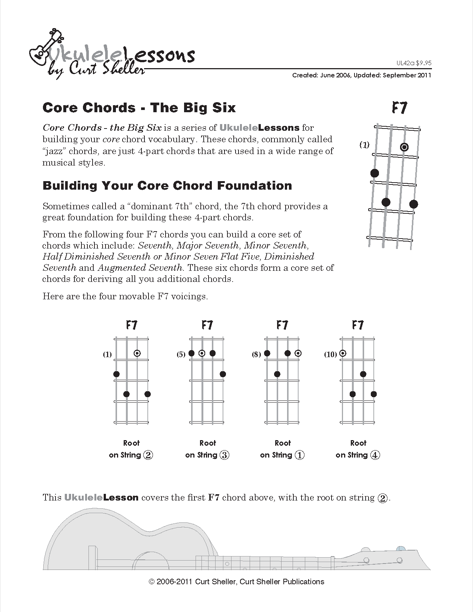
Taking a movable "F7" chord, you can derive each of the Big Six Core Chords. 7, maj7, m7, m7b5, dim7, and aug7 from that voicing.
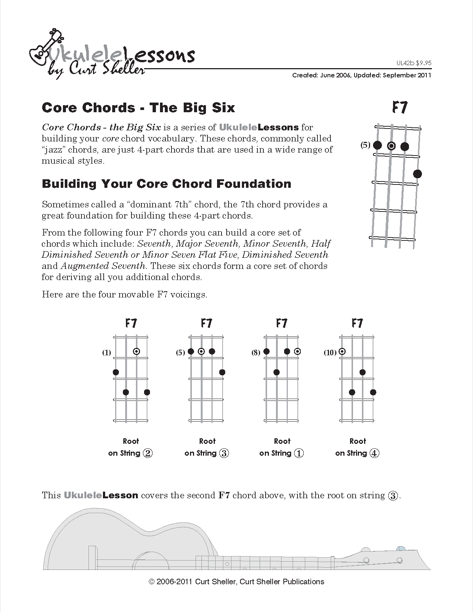
Taking a movable "F7" chord, you can derive each of the Big Six Core Chords. 7, maj7, m7, m7b5, dim7, and aug7 from that voicing.
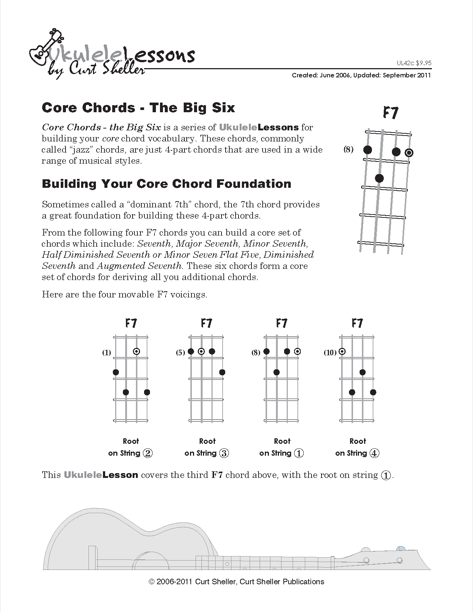
Taking a movable "F7" chord, you can derive each of the Big Six Core Chords. 7, maj7, m7, m7b5, dim7, and aug7 from that voicing.
The 12-bar blues is one of the most popular chord progressions in popular music, including the blues. The blues progression has a distinctive form in lyrics and phrase and chord structure and duration. It is, at its most basic, based on the I-IV-V chords of a key.
The blues can be played in any key. Mastery of the blues and rhythm changes are "critical elements for building a jazz repertoire".
Here is a 12 bar blues chord progression in the key of C major.

The C, F and G chords are the I , IV , and V chords in the key of C Major . Here are all the chords, as triads for the key of C major: C, Dm, Em, F, G, Am, and B°
The V chord, the G can commonly be a 4-part 7th chord. Sometimes called a Dominant Seventh . In the key of C Major the V chord can be a G7 chord.
Here is a lesson taking a deeper look into what is a blues progression.
What Makes “it” a Blues Progression?
Post Chords — Measures one, five, seven, nine and eleven are critical measures where the I , IV , and V chords MUST appear or their direct substitutions for a progression to remain a blues progression.
We can call these chords and the positions that they must fall in, Post Chords.
The most common form of a blues chord progression is twelve measures in length containing three, four measure sections:
- 4 measures of the I chord. ( measures 1, 2, 3 & 4 )
- 2 measures of the IV chord ( measures 5 & 6 )
- 2 measures of the I chord ( measures 7 & 8 ).
- 2 measures of the V chord( measures 9 & 10 )
- 2 measures of the I chord( measures 11 & 12 )
Totaling 12 measures
While other measure lengths are possible, such as eight and sixteen measures, the twelve measure form is the most common.
The simplest blues would actually be the I chord for the twelve measures. Or, an indeterminate number of measures, as the blues where first sung by the field slaves of the southern states in the USA.
Example Blues Progressions
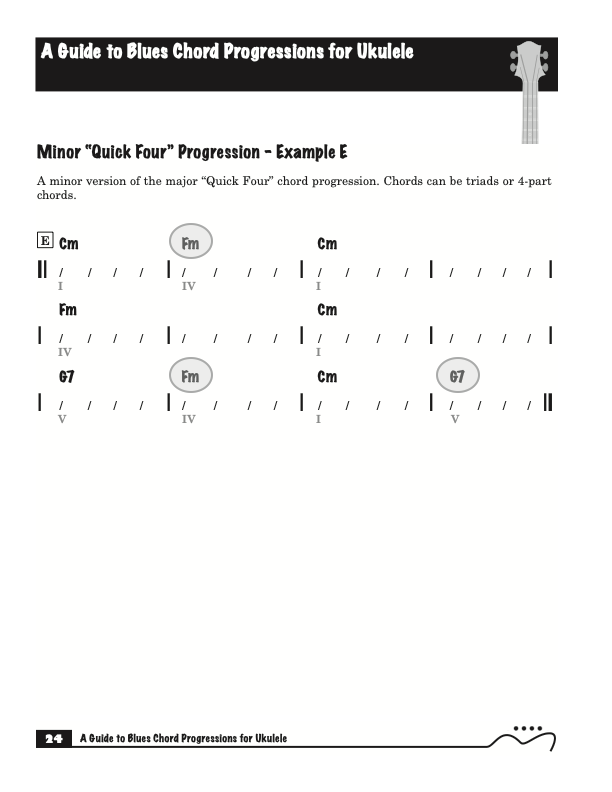
Two blues progressions lessons from Curt's book, A Guide to Blues Chord Progressions for Ukulele A to Z .
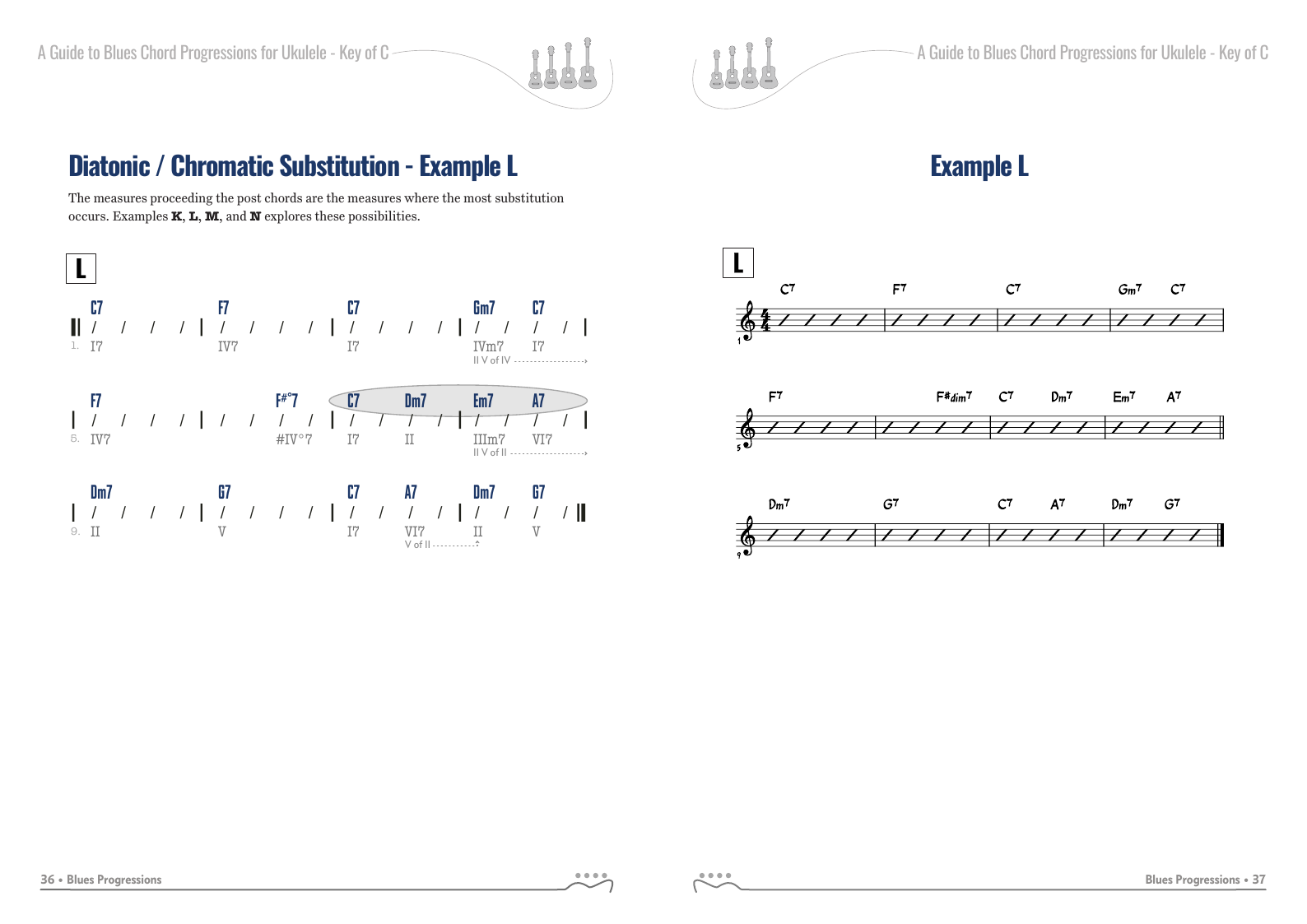
Chord & Chord Progressions Lessons

Two blues progressions lessons from Curt's book, A Guide to Blues Chord Progressions for Ukulele A to Z .

With Chords & Chord Progressions comprising the majority of lesson, here are ALL the lessons tagged for Chords and/or Chord Progressions ).
Studying the blues chord progressions presented in this book will open a wealth of creative possibilities for exploring chord progressions in all styles of music, not just blues.
A Guide to Blues Chord Progressions for Ukulele A to Z starts with a basic three chord, 12 bar blues and progresses through 26 blues progression in C and G tuning up to a sophisticated jazz blues with multiple chord substitutions.
All examples are shown in C and G tuning. Suitable for Soprano, Concert, Tenor, and Baritone ukuleles. Get through this book and you'll have a solid jazz chord foundation to build on.
Available as a FREE PDF download FREE for Premium Members. Hard-copy available.



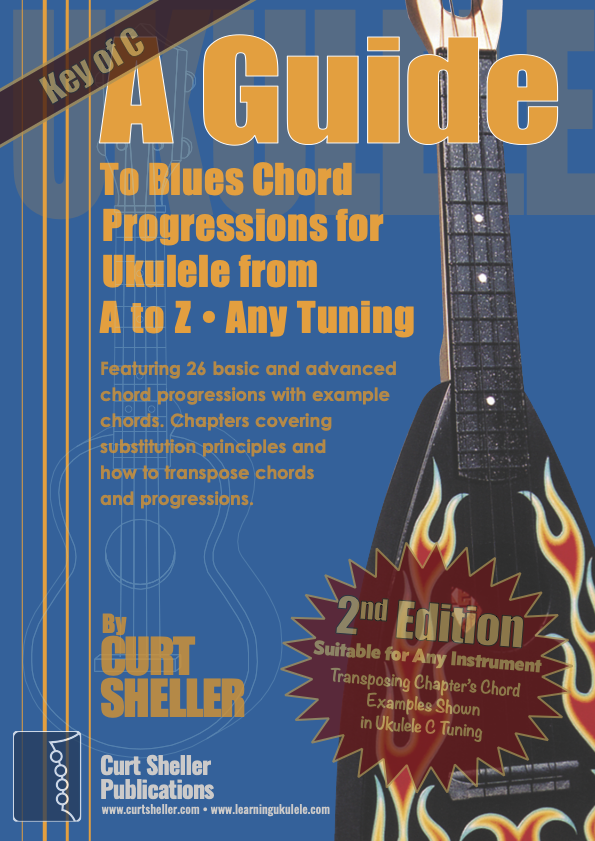
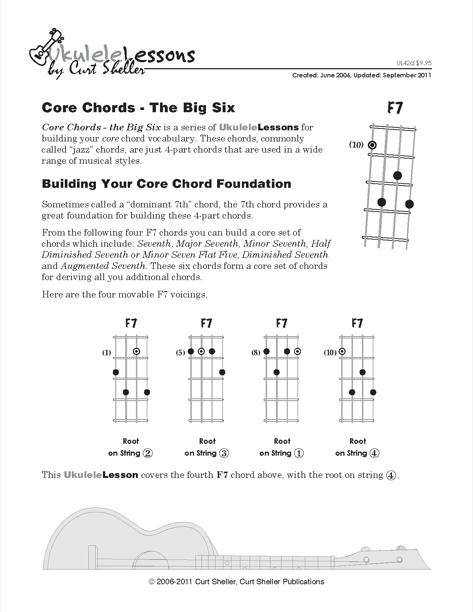
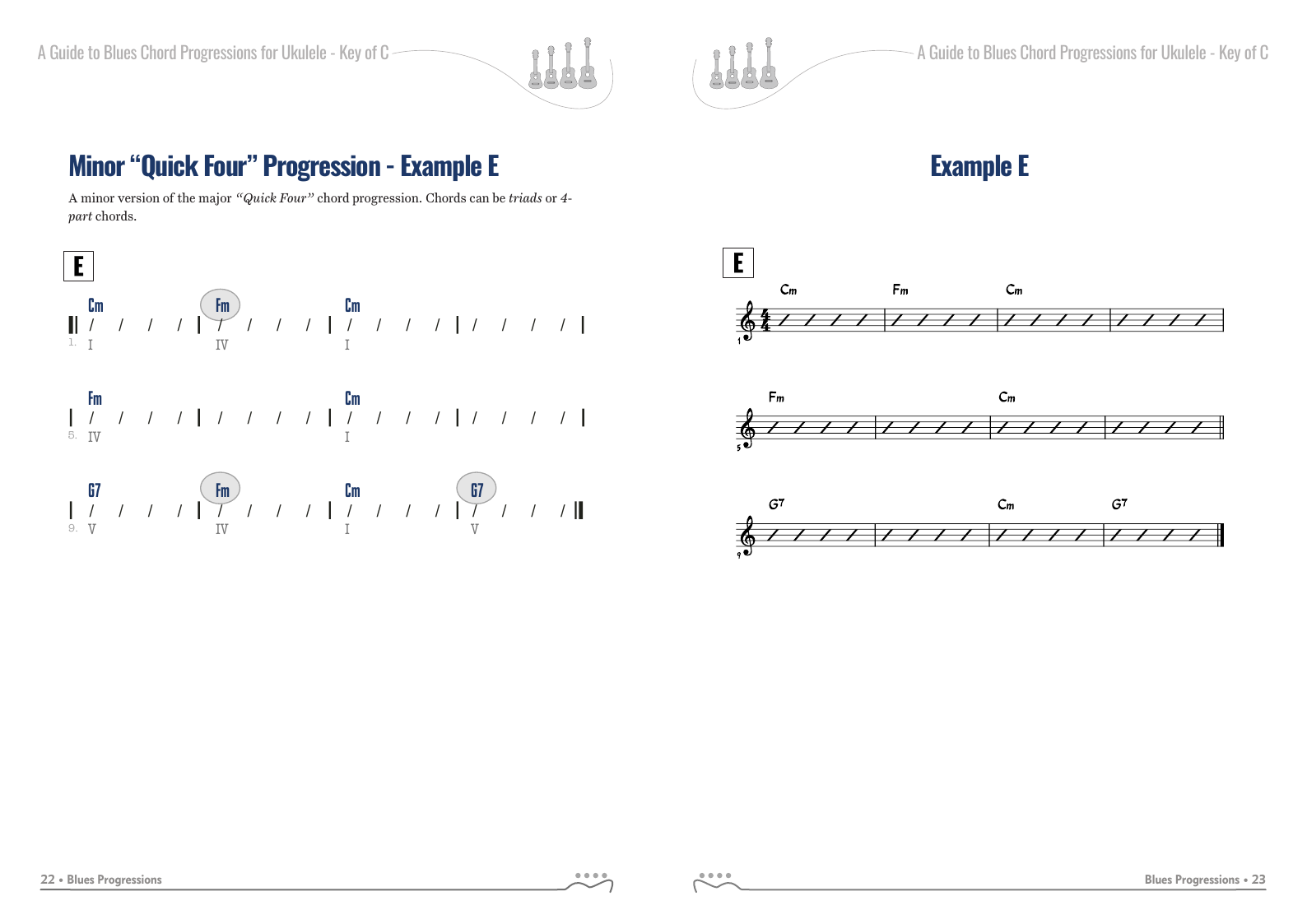
.jpg)